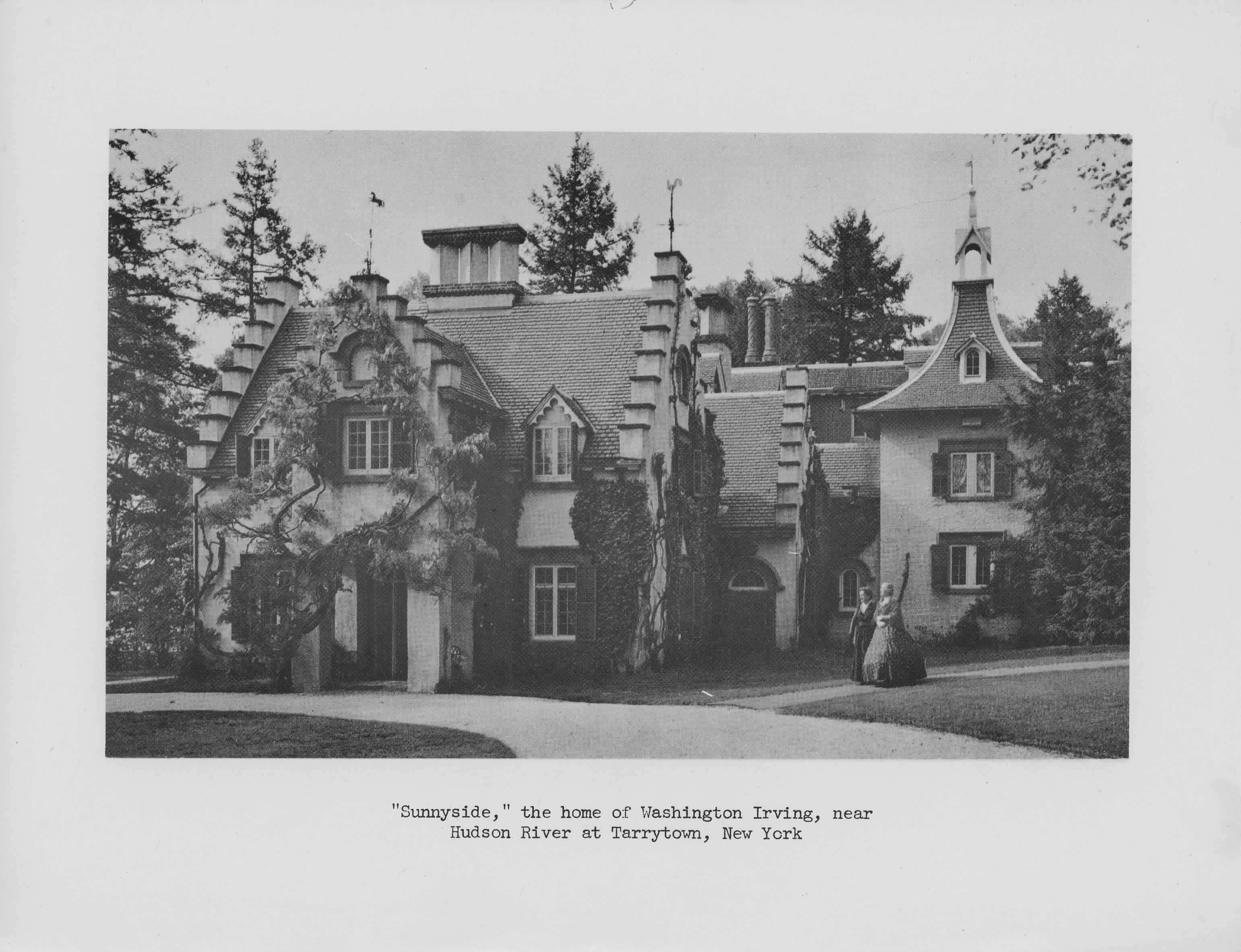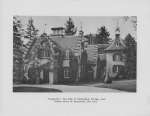"Sunnyside," Home of Washington Irving
1975
Add to Favorites:
Add all page(s) of this document to activity:

Add only page 1 to activity:
Add only page 2 to activity:
Sunnyside was author Washington Irving's estate, located on the Hudson River near Tarrytown, New York. These images and the following descriptions were included with the nomination to add Sunnyside to the National Register of Historic Places.
In 1832, Washington Irving returned to America after 17 years in Europe, to find himself regarded as the foremost prose writer in America. In 1835, he purchased the Van Tassel cottage, a 17th century Dutch house on the Hudson River, below Tarrytown, the setting of some of Irving's bestloved tales. For the last 24 years of his life Irving lived and worked at his estate, Sunnyside, enlarging the house and landscaping the grounds.
Washington Irving was born on April 3, 1783, the 11th and last child of William and Sarah Irving, a Scottish-English mercantile family in New York. As a youth, Irving led a sheltered life, but still managed to pursue his interests in theater, art, music, travel, and social occasions.
Following a trip to Europe between 1804 and 1806, Irving returned to New York, studied for and was admitted to the bar, and began to write humorous short pieces. His first extended project, A History of New York, written under the pseudonym of Diedrich Knickerbocker, was published in 1809. It was an elaborate and intricate satire of old Dutch families of New Netherlands which required much of his time to complete. In this same year, Matilda Hoffman, a young lady whom Irving was deeply attached to, died suddenly. Irving was strongly affected by this and remained a bachelor for life. In 1815, Irving and his brother Peter sailed for London to attend to the family business which was in great disorder. By 1818, the firm was bankrupt and Irving determined to become a fulltime author.
The products of the decision were soon forthcoming and they included; The Sketch Book, 1819-1820; Bracebridge Hall, 1822-1825; The Life and Voyages of Christopher Columbus, published in three volumes in 1828 after his stay as an attache at the United States Legation in Madrid; and A Chronicle of the Conquest of Granada in 1829. Until 1832 he acted as Secretary of the United States Legation in London. In this period he produced two other works including the Alhambra, or the "Spanish Sketch Book," in 1832. During this time, Irving traveled throughout Europe, where he was well-accepted in social and literary circles.
With the exception of "Rip Van Winkle," and the "Legend of Sleepy Hollow," in the Sketch Book, his works were concerned with the nostalgia and history of the Old World. Although romantic and sentimental, his books gained critical and financial success, and earned him praise from such authors as Lord Byron, Thomas Campbell and Thomas Moore, and advice from Sir Walter Scott.
In 1832, Irving returned to America after an absence of 17 years, to be greeted by widespread acclaim and appreciation for introducing American literature to the European mainstream. Irving embarked on a trip through the Midwest and then returned to New York. In 1835 he purchased the Van Tassel cottage at Tarrytown and devoted his time toward the reconstruction of that house in his own personal style. In these years following, Irving's writings became less inspired and tended more towards editing older writings and republishing collected works. Once his house was completed, he invited the motherless family of his brother Ebenezer to live with him at Sunnyside and his little "snuggery" was frequently so crowded that he was forced to sleep in his study.
In 1842, Irving was appointed Envoy Extraordinary and Minister Plenipotentiary to the Court of Spain by President Tyler. Irving had previously been offered the candidacy for the Mayor of New York City and the Secretaryship of the Navy in Van Buren's cabinet, but Irving chose to avoid these more political posts.
Irving returned from Spain in 1846 to Sunnyside, where he began to work on his monumental biography, Life of George Washington. In 1849, he published Oliver Goldsmith: A Biography, and followed this with the two-volume Mahomet and His Successors. The fifth and final volume of Washington's biography had just been published when Irving died quietly at Sunnyside on November 28, 1859. His funeral, which was attended by thousands, was held at Christ Episcopal Church in Tarrytown, and he was buried in the Sleepy Hollow Cemetery, also in Tarrytown.
In 1945, John D. Rockefeller Jr. bought Sunnyside to save it from demolition and open it to the public.
In 1832, Washington Irving returned to America after 17 years in Europe, to find himself regarded as the foremost prose writer in America. In 1835, he purchased the Van Tassel cottage, a 17th century Dutch house on the Hudson River, below Tarrytown, the setting of some of Irving's bestloved tales. For the last 24 years of his life Irving lived and worked at his estate, Sunnyside, enlarging the house and landscaping the grounds.
Washington Irving was born on April 3, 1783, the 11th and last child of William and Sarah Irving, a Scottish-English mercantile family in New York. As a youth, Irving led a sheltered life, but still managed to pursue his interests in theater, art, music, travel, and social occasions.
Following a trip to Europe between 1804 and 1806, Irving returned to New York, studied for and was admitted to the bar, and began to write humorous short pieces. His first extended project, A History of New York, written under the pseudonym of Diedrich Knickerbocker, was published in 1809. It was an elaborate and intricate satire of old Dutch families of New Netherlands which required much of his time to complete. In this same year, Matilda Hoffman, a young lady whom Irving was deeply attached to, died suddenly. Irving was strongly affected by this and remained a bachelor for life. In 1815, Irving and his brother Peter sailed for London to attend to the family business which was in great disorder. By 1818, the firm was bankrupt and Irving determined to become a fulltime author.
The products of the decision were soon forthcoming and they included; The Sketch Book, 1819-1820; Bracebridge Hall, 1822-1825; The Life and Voyages of Christopher Columbus, published in three volumes in 1828 after his stay as an attache at the United States Legation in Madrid; and A Chronicle of the Conquest of Granada in 1829. Until 1832 he acted as Secretary of the United States Legation in London. In this period he produced two other works including the Alhambra, or the "Spanish Sketch Book," in 1832. During this time, Irving traveled throughout Europe, where he was well-accepted in social and literary circles.
With the exception of "Rip Van Winkle," and the "Legend of Sleepy Hollow," in the Sketch Book, his works were concerned with the nostalgia and history of the Old World. Although romantic and sentimental, his books gained critical and financial success, and earned him praise from such authors as Lord Byron, Thomas Campbell and Thomas Moore, and advice from Sir Walter Scott.
In 1832, Irving returned to America after an absence of 17 years, to be greeted by widespread acclaim and appreciation for introducing American literature to the European mainstream. Irving embarked on a trip through the Midwest and then returned to New York. In 1835 he purchased the Van Tassel cottage at Tarrytown and devoted his time toward the reconstruction of that house in his own personal style. In these years following, Irving's writings became less inspired and tended more towards editing older writings and republishing collected works. Once his house was completed, he invited the motherless family of his brother Ebenezer to live with him at Sunnyside and his little "snuggery" was frequently so crowded that he was forced to sleep in his study.
In 1842, Irving was appointed Envoy Extraordinary and Minister Plenipotentiary to the Court of Spain by President Tyler. Irving had previously been offered the candidacy for the Mayor of New York City and the Secretaryship of the Navy in Van Buren's cabinet, but Irving chose to avoid these more political posts.
Irving returned from Spain in 1846 to Sunnyside, where he began to work on his monumental biography, Life of George Washington. In 1849, he published Oliver Goldsmith: A Biography, and followed this with the two-volume Mahomet and His Successors. The fifth and final volume of Washington's biography had just been published when Irving died quietly at Sunnyside on November 28, 1859. His funeral, which was attended by thousands, was held at Christ Episcopal Church in Tarrytown, and he was buried in the Sleepy Hollow Cemetery, also in Tarrytown.
In 1945, John D. Rockefeller Jr. bought Sunnyside to save it from demolition and open it to the public.
This primary source comes from the Records of the National Park Service.
National Archives Identifier: 75316130
Full Citation: New York NHL Sunnyside; 1975; National Register of Historic Places and National Historic Landmarks Program Records: New York; National Register of Historic Places and National Historic Landmarks Program Records, 2013 - 2017; Records of the National Park Service, Record Group 79; National Archives at College Park, College Park, MD. [Online Version, https://www.docsteach.org/documents/document/sunnyside-washington-irving, April 23, 2024]Activities that use this document
- American Authors and Historic Preservation
Created by the National Archives Education Team
Rights: Public Domain, Free of Known Copyright Restrictions. Learn more on our privacy and legal page.





